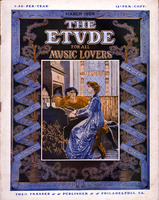In his article on Mark-Neukirchen, Mr. Felix Herrmann gives his readers a clear account of the process of manufacturing cheap fiddles, and helps the inexperienced to understand what is meant by the term: “machine-made violin.” Mr. Herrmann says, in part:
“I should like, first of all, for the sake of clearness, to contradict a certain popular theory, according to which machines are used in the manufacture of violins, violas, violoncellos and basses. I am personally quite ignorant as to whether such machines exist and where they are to be found—certainly not at Mark-Neukirchen, in spite of the vast quantities of instruments which are produced there in one year; and as I paid special attention to this point, I should like to state the fact with all the greater emphasis, and to repudiate all statements to the contrary. How strange it seems, therefore, to find in the last number of The Strad, under ‘Our Sale and Exchange Mart’ (page 222), an advertisement which runs: ‘Wanted, a genuine “hand-made” old violin, price about £4 to £5; good pure tone first consideration.’ Above all, ‘an old violin, made by hand,’ as though machines had already existed at a previous time—say fifty years ago, if such an age is sufficient for the advertiser! It is well known that, especially better-class instruments, for the sake of greater uniformity, are made upon so-called ‘moulds’; the exterior form of a violin or a ‘cello is also sketched upon rough ‘backs’ or ‘bellies’ constructed for this purpose, and then cut out with a circular fret saw; but such appliances can hardly be called machines. The bass makers form an exception, as they make their somewhat clumsy instruments themselves from beginning to end, which is not the case in the manufacture of any other stringed instrument—as is clear from what has previously been said.
“The body-makers of Schönbach do the first part of the work; and by body is meant the primitive form of the violin, with the belly off, not glued on. From the Schachtel makers (body-makers) these bodies pass into the hands of the violin makers, and their first task is to work them, the backs as well as the bellies, to the correct thicknesses according to their theories, which is done by the constant use of the calipers, and also with the help of hollow chisels and very small round planes; then they fit in the bass bar and cut the soundholes with the so-called ‘schnitzer,’ a specially formed knife which is the universal tool of the violin maker. It is only after this that the violin can be glued together and purfled, and the neck and head, which consist of one piece of wood, fitted in. The insertion of the purfling is done by the means of a two-edged knife, which can be adjusted to the exact width of the purfling. With this knife double incisions are first of all made all round, the small space between is cut out with a suitable tool, and the purfling itself is hammered in with a little thin glue, and the protruding part is carefully removed. When the whole violin has been carefully cleaned on the inside with sandpaper of the smoothest kind, the process of varnishing begins, together with all the different manipulations for polishing, rubbing down and reviving the varnish. There only comes the fitting up of the fingerboard, the pegs, the tailpiece, the soundpost, the bridge and the strings.
“Through how many hands an instrument has to pass during all these different manipulations before it appears as the finished article, is difficult to say, for on account of this wholesale system of manufacture it has been arranged in such a way that some men do a certain work, some another kind of work, each into the hands of the other. Whilst formerly violin makers were taught to make their own accessories, such as fingerboards, pegs and bridges, special manufacturers have gradually arisen for such parts, and each maker is exclusively engaged in the manufacture of one particular part. The many villages lying around Mark-Neukirchen have each taken up one of these industries; thus, for instance, Wernitzgruen is the home of the peg manufacturers, and it is said that some of these people can turn out as many as forty dozen a day. Erlbach is the home of the makers of tailpieces, etc. The manufacture of the scrollpieces is not so much confined to one place. The variety in the demand is too great. Some makers supply better, others inferior kinds. Some make a specialty of heads which are carved very artistically, and are to be found on the so-called Tiefenbrucher violins. Lion heads are also a favorite design; but on the whole, the taste, and therefore also the demand, leans towards an elegantly and boldly carved scroll, as to the traditions of the old masters. At Schönbach I saw them at the price of 2s. 9d. per dozen, for which price one could not in this country obtain even a portion of the necessary wood for them. The manufacture of bridges has been retained at Mark-Neukirchen, and here I should like to repeat that they are also cut solely by hand. The idea of having them stamped out, or whatever process may be thought of, is entirely erroneous, and my companions were able to see to what a degree of artistic perfection this work has attained.”



